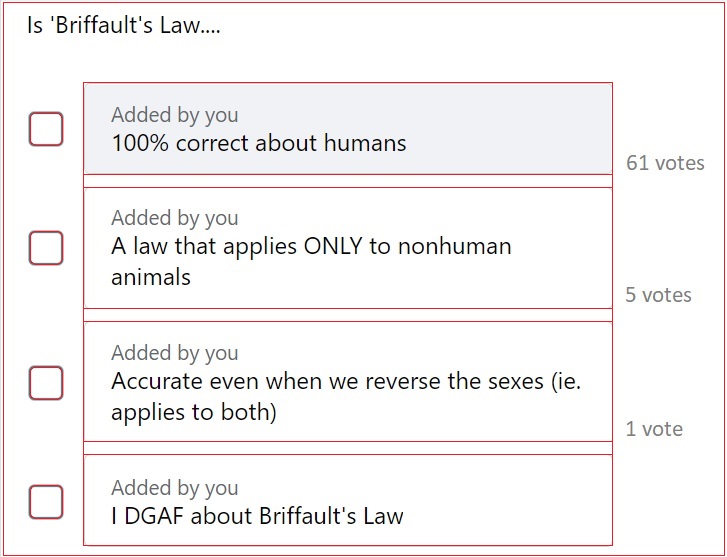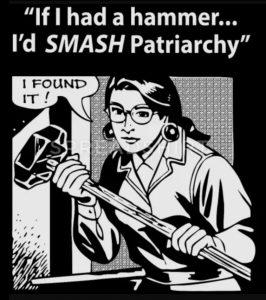This article is in response to Paul Elam and Peter Wright’s excellent recent critique[1] of Briffault’s Law. I have also critiqued Briffault’s law in my article linked here[2]. The manosphere has to have a mechanism of addressing and identifying bad ideas. Bad ideas that are not only factually incorrect, but also hold men back and negatively impact their well-being. These are ideas that must be confronted and challenged, as I have done extensively in my writings debunking the golden uterus mythology and sophistry[3]. In this article I will expand on my past critique of Briffault’s law.
Briffault’s Law is no law at all, like the medieval practice of alchemy it belongs in the bin. The research papers Paul and Peter cited (linked here[4], here[5] and here[6]) on mutual mate choice, sexual dimorphism and sexual selection, are seminal pieces of work. We may have evolved from a species with relatively high to moderate levels of sexual dimorphism many millions of years ago, but we have been on an evolutionary track over the last 500,000-1,000,000 years to evolve into a species with relatively low levels of sexual dimorphism compared to most primates and other animals.
As the evidence discussed in the papers Paul and Peter cite, we are a species where there is mutual mate choice (both sexes choose mates), competition for mates by both sexes, substantial parental investment by both sexes and widespread monogamy, long term mating and pair bonding. These characteristics have been largely the result of the requirements of our increasing brain size over evolutionary time and the longer and longer developmental period of human offspring from infancy to adulthood that has evolved over the past 500,000-1,000,000 years.
High levels of sexual dimorphism, polygyny, lack of dual parental investment, high levels of male intrasexual competition and relatively little female competition etc- modern traces of these patterns are declining artifacts of our evolution that we have been moving away from over the last 500,000-1,000,000 years. Remnants of our old evolutionary baggage are still there in our biology and behaviour, but they are a shadow of their past selves and do not hold the primacy or grip over our behaviour like they once did. New evolutionary baggage in the form of mutual mate choice, dual parental investment and competition, monogamy and long-term mating have moved into the void left behind by the decline of these old traits over the last 500,000-1,000,000 years.
Briffault’s law when applied to humans, relies on biological assumptions that we are a highly sexually dimorphic species in which only one sex competes for mates and only one sex chooses mates and that our old evolutionary baggage is still what primarily governs our behaviour in the present day. These assumptions are completely wrong and incredibly easy to disprove. Yet staunch advocates of Briffault’s law would have us believe that only men compete, only women choose and sexual selection only operates on men.
They would seriously have us ignore 500,000 to 1,000,000 years of evolution, large chunks of scientific research and evidence demonstrating mutual mate choice, dual parental investment and competition, sexual selection on both sexes (not just men), monogamy and pair bonding. They would try to convince us humans are highly sexually dimorphic and still behave like our primitive ancestors did millions of years ago, as if that was a biologically inevitable law of nature (you know the same primates that led to our cousins still living in the jungle and not walking on the moon).
The only people denying biology here are the people that are prepared to turn a blind eye to the clear evidence we are a pair bonding species, with mutual mate choice, dual parental investment, intrasexual competition and sexual selection for both sexes and relatively low levels of sexual dimorphism compared to many animals and many of our primate counterparts.
Briffault’s law is a form of what behavioural biologist Prof. Robert Sapolsky from Stanford university, in his excellent lecture series on human behaviour calls categorical thinking[7]. To a degree we have to think in categories when we analyse information to make sense of the world, but when dealing with complex biological systems this reductive thinking has its limits. When we become fixated on categories and make absolutist statements like Briffault’s law, we get trapped in categorical thinking and cannot see the forest for the trees.
Sapolsky warned in his lecture with numerous examples, the horrific consequences of such thinking throughout history. If you have not watched his lecture series, please watch it. Take it from me, it is an excellent set of lectures and also entertaining. Yes the sexes are different, but not so different that only one sex competes for mates, only one sex invests in offspring, only one sex chooses mates, only one sex faces sexual selection and only short-term mating dominates. That is fiction and not scientific fact.
In his lecture series Prof. Sapolsky quite clearly describes how we are a middle of the road species[8]. That is a species that does exhibit some level of sexual dimorphism, but that does not have the type of high sexual dimorphism like a pure tournament species does where only males compete, only women invest in offspring, only one sex chooses mates and where there is only short-term mating etc. Monogamy, dual parental investment and competition and mutual mate choice in our species, caught on so quickly precisely because it was extremely adaptive to our biology (i.e. long periods of development in our offspring demanding it).
Even in societies that are regarded as polygynous, Sapolsky states in his lecture on behavioural evolution[8], that such so-called “polygynous societies” are in reality only mildly polygynous. The majority of people in these societies are actually not polygamous at all, they are instead in monogamous long-term relationships and pair bonded. Polygyny only occurs to a limited extent in polygynous societies, sometimes for demographic reasons and other times for economic reasons as Sapolsky explains. Many of the proponents of Briffault’s law will gloss over these facts, just as they will gloss over evidence of male mate choice and the clear evidence of sexual selection pressures on females by males and female intrasexual competition for mates.
Now at this point I can almost hear the wailing about how humans are not purely monogamous either in a monogamous setting (i.e there is cheating, short term flings and serial long term relationships throughout life). That is correct, we are not absolutely monogamous. However on a scale with long term relationships, pair-bonding and monogamy on one end and short-term tournament mating and polygamy on the other end, humans are much closer to long term relationships, pair-bonding and monogamy. What we see with humans is the newer evolutionary baggage of mutual mate choice, dual parental investment, both sexes competing and monogamy etc dominating our behaviour and the older remnants of the evolutionary baggage of short-term tournament mating and polygamy playing a more minor role. That is a good thing because it has allowed civilisation to form and stopped societies from tearing themselves apart.
As the papers in the reference section below from Assoc Prof. Steve Stewart-Williams explains (cited by Paul and Peter), humans are at this point in our evolutionary journey closer to the few primate cousins who show very little or virtually no sexual dimorphism, than our cousins at the other extreme that are tournament species. We are not even intermediate in sexual dimorphism, we are somewhere between intermediate and very little sexual dimorphism in a relative sense when comparing humans to many other animals and primates. Our greatest sex differences are mainly as one would expect physical in nature, with height being one of the more obvious physical sex differences beyond basic differences in primary and secondary sex characteristics.
Many of the largest psychological sex differences as the papers from Assoc Prof. Stewart-Williams explains, are far smaller than the sex difference in height. The human sex difference in body size itself is relatively small when compared to the sex difference in body size seen in many other animals and primates. That is not to say sex differences have no significance in humans, it is just that much of the highest levels of significance of sex differences plays out more at the extremes of the distributions of traits in humans and to only a relatively minor extent in the middle. This is true to a substantial extent for physical sex differences (with a significant number of notable exceptions such as the sex difference in upper body strength) and to a very great extent for psychological sex differences.
Of greater significance is how much alike the sexes are in relation to each other overall. In many psychological traits, there is a great deal of overlap in the distributions of many traits between the sexes (see links here[9], here[10] and here[11]) and that also has practical implications. Of course there are also exceptions to the rule, but even then as explained, the larger psychological sex differences are relatively small in comparison to physical sex differences like that observed with height. Even with physical sex differences such as the sex difference in height, there is substantial overlap and we can observe this in everyday life! This is the nuance and complexity that ideas like Briffault’s law do not account for.
Even if we made the incorrect observation that humans are a purely tournament species with high levels of sexual dimorphism and where there is strictly only high levels of male intrasexual competition, and female intrasexual competition is either absent or relatively low, it does not follow that females in such species are freely choosing their own mates and dictating the conditions of their social environment. Firstly, females just like their male counterparts, are restricted by the physical environment itself and secondly, the dominant males exercise a tremendous influence over the females in many tournament species and over the system of mating and social relations in a group. Females are hardly some omnipotent force that bend nature and the males around them to their will. Where is the Briffault’s law in common situations like that in the animal kingdom?
Whilst there are many criticisms that can be made of feminism, it is certainly true that women do have legitimate issues facing them and do face oppression and violence in certain parts of the world. Where is the Briffault’s law there? Where is the female omnipotence? This is what happens with categorical thinking, people start dismissing aspects of reality that don’t fit their dogma just like many feminist ideologues do. Staunch followers of Briffault’s law have more in common with feminist ideologues than they think!
The reality is we don’t get civilisation without paternal investment in offspring by males and monogamy. These changes ensure that society remains stable enough and there is sufficient investment by both sexes in their offspring, to foster the development of civilisation. We could not develop civilisation if we were a tournament species. This is one reason why enforced fatherlessness from feminist social engineering attacking fatherhood at an institutional level and the feminist corruption of our legal system to alienate children from their fathers, is so dangerous. You can read the statistics[12] on fatherlessness and its effects on society. It is not a pretty picture.
Once you switch to monogamy, dual parental investment and long term mating, mutual mate choice occurs and sexual selection and intrasexual competition is observed in both sexes and that is exactly what we observe in human society. The reality is that Briffault’s law assumes that males are not choosey, which is based on a deeply flawed assumption all forms of mating with females are short term flings and only involve the exchange of gametes. As mentioned earlier, the scientific evidence reported by Assoc Prof. Stewart-Williams shows this not to be the case at all in humans. Males do choose mates as well and females do compete with each other for mates just as men do.
We have whole swathes of men now distancing themselves from marriage and certain types of women, precisely because men are assessing the situation and choosing not to marry or be around certain women. That is male choice in the dating world right there. We have whole swathes of women complaining about this situation and about where all the good men went as a result. It does not take much of an observation to debunk Briffault’s law and this twisted view of women being omnipotent. Men walking away from the modern corrupt form of marriage, divorce and family court is just one example of where Briffault’s law fails, but I can cite many more examples.
In many ways Briffault’s law is the manospherian equivalent of patriarchy theory and the feminist notion men have all the power. Both are held up as an unquestioned dogma by their relevant followers and have an almost religious following that is impervious to reason and facts. Both are completely wrong. Both sexes have power and influence in this society, both sexes can and do take advantage of the other and both sexes do cooperate with each other. We need to foster greater intersexual cooperation to the fullest extent possible. If not for the sake of men’s interests or women’s interests, for the sake of our children, future generations and for a society that is becoming more and more divided by the day. We don’t go anywhere but backwards as men, as women and as a society, if we let half-baked ideas like Briffault’s law and patriarchy theory spread as some sacred cow belief system. Such beliefs blind us from seeing the bigger picture and divide us.
Yes gynocentrism is a powerful and destructive force in society, but it is not an unassailable omnipotent force like what Briffault’s law would have people believe. There are also other powerful forces as well at work in society that can and do override gynocentrism. That even applies to our Western culture which is significantly gynocentric. It is obvious just looking at society with a cursory glance, that women (even ranting and raving feminists) do not always get their way and conditions in society are not determined solely by women. Briffault’s law speaks of female omnipotence in absolutes and so does its ardent followers, just like feminists do with patriarchy theory and male privilege. This is at odds with reality and with science.
In closing, I can think of nothing more gynocentric than a belief like Briffault’s law that women control all of the conditions of social interaction and men are merely their pawns. Briffault’s law is a self-defeating belief that is not only factually incorrect, it holds men back, just as patriarchy theory does with women. It is an absolutist worldview that when followed to its logical conclusion, leads to men giving up on themselves and society, especially when it comes to their interactions with women. Any solid and healthy philosophy to assist men has to be based on the premise that men should base their beliefs on facts, not on fiction, and develop a worldview to maximise their well-being instead of fostering a mindset of learned helplessness.
Briffault’s law is a self-fulfilling prophecy that only leads to the death of the male self and eventually by extension, if it causes enough social damage to men, the death of society. There is nothing red pill about it, it is a gynocentric black pill of death.
References:
1. https://www.youtube.com/watch?v=uMJYYlbHld0&t=448s
2. https://gynocentrism.com/2020/01/31/gynocentrism-sex-differences-and-the-manipulation-of-men-part-one/
3. https://gynocentrism.com/2021/01/15/the-fallacy-of-the-golden-uterus-and-the-true-origins-of-gynocentrism-part-one/
4. https://www.stevestewartwilliams.com/publications/Stewart-Williams%20&%20Thomas,%202013.pdf
5. https://www.psychologytoday.com/files/attachments/33284/stewart-williams-thomas-2013bpi.pdf
6. https://www.stevestewartwilliams.com/publications/Stewart-Williams_2020_peacocks_or_robins.pdf
7. https://www.youtube.com/watch?v=NNnIGh9g6fA&list=PL848F2368C90DDC3D
8. https://www.youtube.com/watch?v=Y0Oa4Lp5fLE&list=PL848F2368C90DDC3D&index=2
9. https://www.apa.org/pubs/journals/releases/amp-606581.pdf
10. https://www.semanticscholar.org/paper/Gender-similarities-and-differences.-Hyde/25f3145d6f4dc126c41948b03c07502dc7b20e3a
11.https://www.researchgate.net/publication/271722875_Evaluating_Gender_Similarities_and_Differences_Using_Metasynthesis
12. https://www.fatherhood.org/father-absence-statistic






